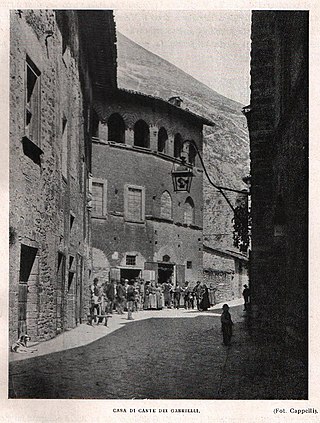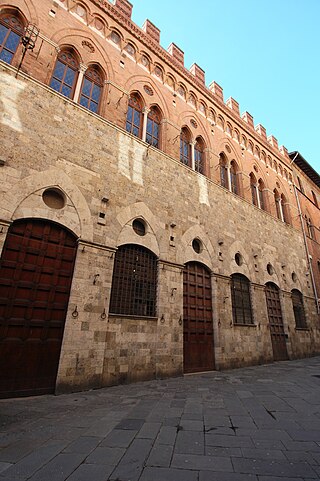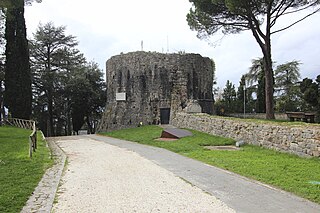
Palazzo del Capitano is a Gothic architecture, late 13th-century civic palace in Todi, Italy. [1]

Palazzo del Capitano is a Gothic architecture, late 13th-century civic palace in Todi, Italy. [1]

Todi is a town and comune (municipality) of the province of Perugia in central Italy. It is perched on a tall two-crested hill overlooking the east bank of the river Tiber, commanding distant views in every direction. It was founded in antiquity by the Umbri, at the border with Etruria; the gens Ulpia came from Todi.

GiacomoBarozzida Vignola, often simply called Vignola, was one of the great Italian architects of 16th century Mannerism. His two great masterpieces are the Villa Farnese at Caprarola and the Jesuits' Church of the Gesù in Rome. The three architects who spread the Italian Renaissance style throughout Western Europe are Vignola, Serlio and Palladio. He is often considered the most important architect in Rome in the Mannerist era.

The Bargello, also known as the Palazzo del Bargello or Palazzo del Popolo, is a former barracks and prison in Florence, Italy. Since 1865, it has housed the Museo Nazionale del Bargello, a national art museum.

Piazza dei Cavalieri is a landmark in Pisa, Italy, and the second main square of the city. This square was the political centre in medieval Pisa. After the middle of 16th century the square became the headquarters of the Order of the Knights of St. Stephen. Now it is a centre of education, being the main house of the Scuola Normale di Pisa, a higher learning institution part of the University.

Palazzo dei Papi is a palace in Viterbo, northern Latium, Italy. It is one of the most important monuments in the city, situated alongside the Duomo di Viterbo. The Papal Curia was moved to Viterbo in 1257 by Alexander IV, due to the hostility of the Roman commune and constant urban violence: the former bishop's palace of Viterbo was enlarged to provide the Popes with an adequate residence. The construction, commissioned by the Capitano del popolo Raniero Gatti, provided a great audience hall communicating with a loggia raised on a barrel vault above the city street. It was completed probably around 1266.

Gothic architecture appeared in the prosperous independent city-states of Italy in the 12th century, at the same time as it appeared in Northern Europe. In fact, unlike in other regions of Europe, it did not replace Romanesque architecture, and Italian architects were not very influenced by it. However, each city developed its own particular variations of the style. Italian architects preferred to keep the traditional construction methods established in the previous centuries; architectural solutions and technical innovations of French Gothic were seldom used. Soaring height was less important than in Northern Europe. Brick rather than stone was the most common building material, and marble was widely used for decoration. In the 15th century, when the Gothic style dominated both Northern Europe and the Italian Peninsula, Northern Italy became the birthplace of Renaissance architecture.
Luzio Luzi, also known as Luzio Luzi da Todi and Luzio Romano, was an Italian painter, stuccoist, and draftsman of the High Renaissance era favoring the Mannerist style.

Villas and palaces in Milan are used to indicate public and private buildings in Milan of particular artistic and architectural value. Milan has always been an important centre with regard to the construction of historical villas and palaces, ranging from the Romanesque to the neo-Gothic, from Baroque to Rococo.

The Palazzo del Capitano del Popolo or Palazzo di Cante Gabrielli is a medieval palace in Gubbio, Italy. It is located in the San Martino's quartiere, near Porta Metauro, at the corner of via Gabrielli and via Capitano del Popolo.

The Palazzo della Congregazione dei Nobili, better known as Palazzetto dei Nobili or “Oratorio dei Nobili”, is a historic building of L'Aquila in Southern Italy.

The Palazzo del Capitano del Popolo is a 13th-century Gothic style, brick and stone, urban palace located on via del Capitano, #13-19 in the city of Siena, region of Tuscany, Italy. The name derives because it was once home of the Capitano della Guerra or Capitano del Popolo, who served as the main official for the Republic. The Palazzo is just off the Piazza of the Duomo.
Palazzo del Capitano del Popolo may refer to:

The Museo Civico di Sansepolcro or Museo Comunale is the town or comune art gallery. It is housed in a series of linked palaces, including the medieval former Palazzo della Residenza, the Palazzo dei Conservatori del Popolo and the Palazzo del Capitano o Pretorio, located on Via Niccolò Aggiunti #65, near the center of Sansepolcro, formerly Borgo Santo Sepolcro, in the Province of Arezzo, region of Tuscany, Italy. The museum was founded in 1975.

Piazza del Popolo is a city square in Todi, Italy.

Palazzo dei Priori is a palace in Todi, Italy.

Palazzo del Popolo, also called Palazzo del Priori or Podesta, is a Gothic architecture civic palace in Todi, region of Umbria, Italy.

San Carlo, formerly Sant'Ilario is a small Romanesque and Gothic-style, Roman Catholic church on Viale San Carlo and intersection with Via Cesia and della Piana, below the Piazza del Mercato Vecchio, in the center of Todi, province of Perugia, region of Umbria, Italy.

The Todi Columns are four Corten steel columns designed by the American artist Beverly Pepper, and now installed at the Beverly Pepper park located on Via Valle Inferiore #6 in Todi, region of Umbria, Italy. The site is part of the Parco della Rocca: a park built at the ruins of a 14th-century castle, of which a crumbling round former stone keep (donjon) rises a few yards from the columns. The park has a view south and east along a valley of the Tiber river.

The Tempio del Santissimo Crocifisso, also spelled as Tempio del SS Crocifisso was erected as a Renaissance-style, Roman Catholic sanctuary church on Via del Crocifisso #10, about 200 meters Northeast of the Porta Romana, just east of former medieval walls of Todi, province of Perugia, region of Umbria, Italy. It now serves as a parish church.